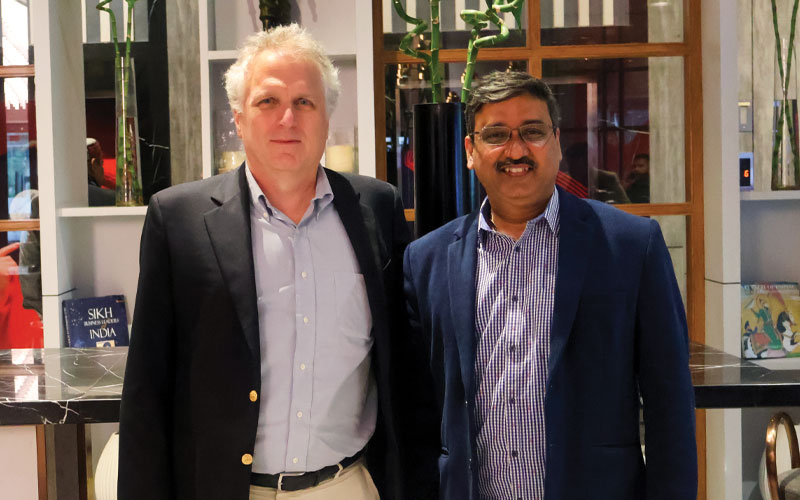BTG Group is looking forward to a robust growth in the Indian pulp and paper industry through a slew of measures, including business footprint expansion, hiring of new talent and further expanding their Center of Excellence in Hyderabad. The company foresees doubling of capacity in India in the next 10-15 years and says it is well-positioned to accelerate its position in the Indian market. This was revealed by Dr. Dan Smith, Business Director, Process Solutions at BTG Group and Mr. Akhlesh Mathur, Head of Business South Asia & Southeast Asia for BTG Group, during an exclusive interaction with Paper Mart.

Paper Mart: Please tell us about the most recent innovations in BTG Group’s product portfolio catering to the pulp and paper industry.
Akhlesh Mathur: A lot of technological innovations have been going on in the BTG world in process and control business, as well as on the consumables side of the business. We have completely transformed our business operations in the past decade, focused entirely on customer engagement and satisfaction. Our field force spends a disproportionate amount of time understanding our customer’s pain points and priorities aligning with their business goals. Our global + local teams after relevant audits and data analysis develop customized and grounded solutions to solve our customer’s problems in a sequential way, while making sure that the benefits they get at the end of these solutions are also sustainable.
Another technology expansion event took place last year when we acquired FITNIR Analyzers Inc, a Canadian company that started as a JV between PAPRICAN (now FP Innovations) and Kvaerner Chemetics. This brings to BTG a novel online anlayzer based on FT-NIR spectroscopy that provides key measurements for process optimization in the liquor phase (online and benchtop units) and ultimately cost savings to pulp mills. While BTG Group had a very strong portfolio as a provider of highly-specialized process solutions for the global pulp and paper industry, it hardly had any presence on the liquor side. With FITNIR, we have come full circle. It has broadened our product offerings, including in cooking, bleaching & chemical recovery, and made us a multinational provider of end to end process solutions for the paper market.
Dan Smith: We’ve been in the consistency business for over 100 years now. BTG Group has a deep portfolio of solutions that transform operations at pulp mills, tissue, paperboard and paper mills to increase overall business performance, with proven benefits at all levels. We recently launched MEK Stratus, the latest version of our highly-successful fifth-generation MEK-3000 rotary consistency transmitters and the first instrument to seamlessly connect with the new BTG Stratus platform. This rotating inline transmitter gives the customers critical information about the production rate of their paper machine, bleach plant and digester by measuring the consistency rate. With twice the torque, stronger motors and no need for sealing water, MEK Stratus offers highly accurate consistency measurements and reduced maintenance. It can handle hot and humid work environments, which makes it ideal for a wide range of applications.
In addition, we have in place a robust process of continuous review of our product and solutions portfolio through periodic mapping exercises from the ground level and then developing or acquiring technologies as required to fill any gaps. We are fortunate to operate as an “Automation arm” of Voith Paper, which fills up the vision of Voith of being a full line supplier and a very relevant and capable parent organization to nurture the development pipeline.
PM: How does the BTG Group stand ahead of its competitors in the global pulp and paper industry?
DS: We’re continually investing in Research and Development (R&D). Our R&D strategy is quite focused on solving practical problems that help our customers run their operations more efficiently and smoothly. Every year, we come out with some new instruments or analyzers, along with upgrades of existing ones. It’s a never-ending process of inventing new things and upgrading existing products.
AM: What really sets us apart from our peers and makes us feel more engaged and meaningful is the way we help our customers solve their problems. We are a very lean and efficient organization, but a niche player in the market we operate in. We have a very strong presence on the ground across regions and geographies. Around two-third of our team works on site, in collaboration with our customers, constantly calibrating ourselves with ever changing customer needs.
Watch: In Pursuit of Lesser Water Footprint
PM: How do you help the paper industry to leverage the benefits of Artificial Intelligence (AI) and Internet of Things (IoT)?
DS: It comes from the way we do business. We work thoroughly with our customers. It starts by meeting the customers and engaging in discussion about the problems they’ve been encountering. We give them an insight into where exactly the problem lies, followed by an idea of problem-solving techniques and then work collaboratively with them for solutions. We also support our customers after the project to help them realize the sustainable benefits from the same.
AM: We have deployed a lot of AI-based solutions in the region including in India across different processes in paper mills. We have experience at ground level to support our customers traverse any digitalization journey as a consultative approach and indeed have capability to then implement these solutions seamlessly handholding and often in phases. This provides confidence to the customers that they’re not touching something brand new or unproven.

We’ve replicated in India- what we had in Sweden. The decision was not driven by the cost factor alone. We realized that there’s a lot of high technical talent in India and wanted to take advantage of that. This has worked out really well.
PM: Kindly share details about your close collaboration with Indian paper mills.
AM: We provide solutions to customers like Kuantum Papers Limited, Orient Paper Industries Limited (OPIL) and JK Paper Limited. In almost all cases, we have entered into a multi-year relationship journey with them upfront. Though it took a lot of effort to reach there, the journey has been pretty interesting. Engaging at the right level in an organization is very important. Customers only want to talk to you when they trust you and building that trust is the first step. We first understand their problems and then present to them a plan that is practically possible to do, financially feasible, technically achievable, and also profitable. Doing a project or digitalization with no financial benefit is of no use. We really harp on that a lot.
PM: Elaborate more on the scope of solutions you offer to a customer as part of this relationship.
AM: In almost all cases, we work together with the leadership to develop a clear roadmap of what exactly needs to be done. We make sure to have a very good understanding of the ground realities and processes, including the overarching objectives of the mill and the capabilities of the organization. We also take note of other developments going on in the plant, such as the mill rebuilding a machine or adding some new equipment. We initially focus on low-hanging fruits, do them first and then take other longer projects, financed in phases.
Execution is another important step. Providing hand-holding support and SME’s at every step is critical in this journey and in executing these kinds of projects. You can have all the sweet talks, but if you don’t have the right people on ground doing the right things at the right time, you can’t achieve anything. We are blessed to have a robust infrastructure and good resources to cater to those projects. Being a conservative business group, we believe in promising reasonable returns and overdelivering during execution instead of other way round.
DS: We have been working for several years now to pull that capability together. We have been diligently building up a team for more than six years now. A part of that is having our Center of Excellence in Hyderabad, attracting top-level employees. It’s been a continuous process.
Also Read: Lamacart: Strategic Partner of Green Economy
PM: Kindly share details about your market footprint in India.
AM: Till seven years ago, in India, we had 6-7 people, mostly customer-facing persons covering the market and a small service center in Hyderabad. We were more of a supplier than a partner to the industry. Then we decided to change things. We started making investments, hired more people on the ground, including in technical support, sales and service departments. India was presented as BTG’s another technical node supporting the BTG factories in Europe. The decision aligned with our aim to develop a resource footprint in India to support our global growth targets.
DS: We have an R&D group here in India for instrumentation, software and product management. Basically, we’ve replicated in India- what we had in Sweden. The decision was not driven by the cost factor alone. We realized that there’s a lot of high technical talent in India and wanted to take advantage of that. This has worked out really well.

We have been diligently building up a team for more than six years now. A part of that is having our Center of Excellence in Hyderabad, attracting top-level employees.
PM: What are your future plans? Where do you see yourself in India in the next 5-10 years? Do you plan to cater to any new overseas market?
DS: Our Indian team overlooks global operations. They are supporting the solutions and projects all over the world. The business is growing in Asia. India is our center for supporting Asia. It will continue to grow like it has been for the last six years.
AM: We have an ‘India for India’ and ‘India for World’ strategy. When it comes to ‘India for India’, we are hiring people here in sales, application and service departments, to support the Indian market. As for ‘India for World’, we have hired mechanical engineers, software engineers and advanced control engineers to cater to the global market.
We are expanding our office space and hiring more people in our team. We also plan to build a digital experience center in Hyderabad. In addition, Voith is also planning to operate some of their On Performance Lab (OPL) operations from our Hyderabad office.
PM: What are some of the challenges you encountered in the Indian paper industry?
AM: I see talent as one of the biggest challenges for the Indian paper industry. The experienced people retention rate is low. The paper industry has not been a very attractive workplace to attract the best of talent. It poses a challenge because you still need to run the machines and the show as well. If you don’t have all the talent required to run those machines, you have to depend on something else. That’s where we slice in.
The second challenge for India has been around raw material. Wood-based raw material is scarce in India. There is an opportunity for the Indian paper industry on the sustainability front, as compared to Indonesia, China, or Brazil. There’s a difference in their business model. If you talk to an entrepreneur in Brazil, they first build a forest, followed by a pulp mill and paper machine. We believe the industry leaders are learning from other countries and taking measures to have a more sustainable virgin fiber basket to keep up with the demands of different paper grades. Recycle fiber supply dynamics is also changing rapidly and there are huge opportunities to come up with innovative ideas around optimizing yield and efficiently separating contaminants.
The third challenge is the environment. The Indian paper industry has not been very careful with their environment. There is a cost of compliance which the industry has not paid so far. If you delay further on that then it will get worse.
DS: Uruguay is also a good example. They started by planting trees and in the past 25 years, they have gone from zero pulp mills to three mega mills. It all started with farmers devoting their land to growing trees.
PM: What kind of role does BTG Group foresee will be played by automation and AI in the pulp and paper industry in the next decade?
DS: For companies like us, the support is going to come globally as we’re more and more connected. It won’t matter where people are, we’ll be able to support our customers 24×7. We have systems in place, experts of data and process. We have support from North America and Europe. One of the reasons we are here is finding capable people to provide that support.
Many of our customers want to cover a couple of years or decades worth of journey in a one or two year space. It’s quite exciting and interesting to see their commitment to leaping, starting their journey from valves and instrumentation to data systems, advanced controls and ultimately AI & automation.
AM: The Indian paper industry has been shy of investing enough in automation. Automation could start with having proper valves and other field instruments, making sure that these are controlled and maintained well. Then comes the DCS level controls which are often sub-optimized. This foundational infrastructure is critical to have before we harp on reaping benefits out of AI or any other advanced technologies.
The capacities in India are expected to double in the next 10-15 years. The new asset owners should think about talent, raw material and environment as well in addition to selecting the right technology (including automation).
I think AI and automation have a competitive edge. During the good times, they help you make more money, while in bad times, they become your survival index.

The business is growing in Asia. India is our center for supporting Asia. It will continue to grow like it has been for the last six years.



